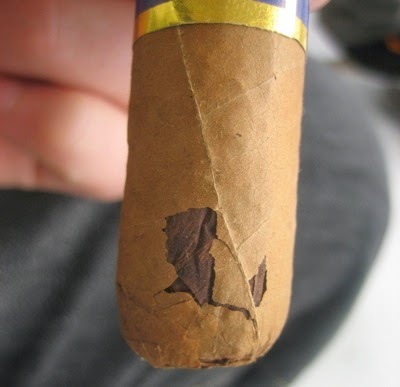It is the same with cigar smokers, they usually can describe why they like it but not much why they do not like it.
It can be indeed a question of personal taste but it can also be due to a defect on the cigar they just smoked.
I knew myself a few defects and how to explain them but after reading a very good book relating the traditional " seed to smoke" story but seen by the eyes of an agricultural engineer, i got a more detailed and scientific approach to the subject.
This book was written by Didier Houvenaghel in 2006 and is called " From Soil to Soul" (English version). If you are really into cigar knowledge, i definitely recommend the read.
Defects are numerous and have different origins. Let's go thru every single of them.
1) Storage Issue
- The humidity conditions of the storage are not met
- Too moist, some mold will develop and will affect the outlook and the taste of the cigar
- Too dry will caused the evaporation of the water contained in the leaves but also the disappearance of the oils and resins which will be decrease the aromatic quality of the leaves and leave a dusty taste.
- The ventilation conditions of the storage are not met
- Too little will increase the risk of moldy environment
- Too much will increase the risk of dryness of the cigars
- Storage in an over-lighten environment
- Too much direct light will affect the quality of the wrappers, fading their color and reducing aromas.
- Too much direct light will dry the cigars
- Rough storage
- If the cigars are not properly stored the wrapper may be teared or the foot may be split
2) The sight (wrapper)
- Green Wrapper
- The wrapper lacked technical maturity during harvest
- The drying has been speed up by increasing temperature
- Such wrapper does not have aromatic qualities having a higher concentration of substances such as chlorophyll pigment.
- However during a certain period green wrapper were deliberately created for the U.S market as some cigar lovers enjoyed such characteristic. It is called "Candelas"
- Dark to Black Wrapper
- The type of soil
- The wrapper being too thick and too oily, darkens during the various treatment
- The fermentation was too long
- Wrappers from some types of tobacco plant are more sensitive and will darken more easily
- Lack of glossiness
- Unsuitable soils
- Unfavorable climatic conditions during the growth of the plant
- The harvest was done when the leaves were too mature
- Not enough water in the leaves when harvested
- Excessive temperatures during drying and fermentation
- Storage in too dry condition causing a evaporation of the oils
- Green spots
- Faulty drying : high temperatures caused a rapid loss of water leading to the quick precipitation of the pigments
- Small damaged done to the leaves which increased the concentration of chlorophyll around it
- Presence of chlorophyll will decrease the aromatic quality of the cigar.
- Dark green spots
- High level of humidity during the drying due to water saturation in the leaf. The concentration of those dark green patches in a part of the cigar is called "snakeskin"
- Yellow spots
- Lack of humidity during drying process resulting in this yellowish pigment
- Black spots
- Result of a very high humidity during drying, preventing the elimination of the sugars and starch content in the leaf, the patches will turn black during fermentation
- The cigar will have an unpleasant and irritant taste due to the concentration of the sugars and starch
- White spots
- Result of a fungus disease called "Cercospora" that appear on mature leaves, which reduce the quantity of chlorophyll before the leaves are harvested.
- Larger spots are result of another fungus disease called "Moho Azul" that appear on green leaves around the veins
- White or black veins
- Environmental disease
- Nutritional deficiency resulting from poor soil or insufficient fertilization
- Fluctuations of humidity and/or of temperature during drying process
- Tears
A dry cigar will be easier to damage
- Loose wrapper
- The wrapper hasn't been properly stretched to the bunch.
- Not enough elasticity in the wrapper used
- A twisted vein exerting a physical stress
- Irregular cut of the foot
- Badly sharpened guillotine used after the rolling
- Hesitant movement from the roller
- The leaves used were too dry and even with a sharp guillotine it will caused some splits in the wrapper.
- Turns of the wrapper along the cigar
Beyond that it is evident that the cigar will be badly rolled or that the wrapper used
was too small or thin for the bunch.
However for longer cigars will require more overlaps
- Holes due to Lasioderma Serricorne L.
- The larvae of this beetle, in the form of small worms, feed on tobacco leaves, wheteher rolled or loose, and they leave large numbers of holes.
- When they attack a cigar, the larvae bore galleries which upset the combustion by modifying the flow of air to such extend that the cigar is ruined.
- White Mycelium on the internal leaves of the cigar
is the fruit of an attack of the Moho which develops during the fermentation phase.
This Moho ( unlike the Moho Azul) gives an unpleasant and characteristic smell to the cigar.
(TO BE CONTINUED......)










Checkout our website for buying guide about cigar humidator.
ReplyDeleteCigar Humidor